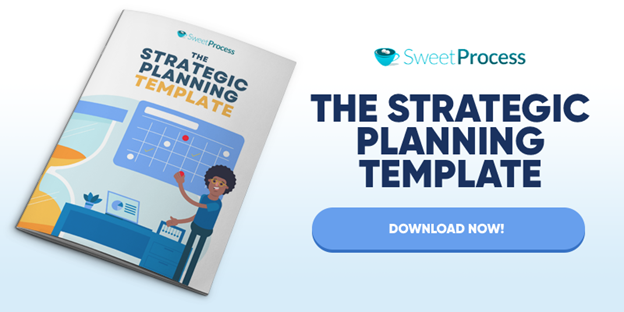Last Updated on March 7, 2025 by Owen McGab Enaohwo

Alfred had been running his business for years, and he started to feel like it was time for a change. He wasn’t sure what he wanted to do but knew that he needed to upgrade his business somehow. He contacted a business support consultant who told him about the importance of using a strategic plan. According to the consultant, this would be the best way to achieve great results.
Are you a business owner who is in the same boat as Alfred? Are you feeling like you don’t have enough time to do everything and that your business is just stagnating? Well, don’t worry—you’re not alone. All companies go through these growing pains, and there’s a simple solution: strategic planning. Strategic planning can help you organize your thoughts and figure out where your business should be going. In this executive guide, we’ll show you how to do it. So read on—your business depends on it!
Chapter 1: A Brief Primer to Strategic Planning
Chapter 2: Benefits of Strategic Planning
Chapter 3: The Strategic Planning Process
Chapter 4: Top 7 Software for Strategic Planning
Chapter 5: How to Adapt and Evolve Your Strategic Goals Using SweetProcess
Chapter 1: A Brief Primer to Strategic Planning

What is Strategic Planning?
Strategic planning is a means to an end. It is a systematic approach to making decisions that enable an organization to achieve its desired outcomes. It is a continuous cycle.
It involves taking into account current and projected environmental conditions to chart the company’s future direction while at the same time providing essential information that the business owner will use to take action. You can think of it as mapping out your route before taking a journey, making the most effective use of available resources to reach the intended destination.
A simple way to understand strategic planning is to view it as an ongoing, iterative decision-making process that involves companies constantly examining their internal and external operating environments to investigate opportunities for growth while minimizing threats.
Johnson and Scholes define strategy as “…the direction and scope of an organization over the long-term, matching its resources to its changing environment and, in particular, its markets, customers and clients, to meet stakeholder’s expectations.” Their definition emphasizes satisfying stakeholders’ needs.
Henry Mintzberg, a Canadian academic and author on business and management, defined strategy as “a carefully intended course of action whose resulting behavior can be identified.” He believed that strategy is a pattern that should be a reality, not a theory.
Popularly associated with Porter’s five forces, Michael Porter, the founder of modern strategy, defined strategy as “deliberately choosing a different set of activities to deliver a unique mix of value.” He believes that you need to be aware of what your competitors are doing to create something distinctive and of great merit.
Purpose of Strategic Planning
1. To provide a road map of where we are going—and how we intend to get there.
2. Ensure that the business is not distracted by unprofitable projects and initiatives.
3. To prioritize future growth opportunities.
4. To ensure all key stakeholders (shareholders, employees, customers, suppliers) know the company’s intentions.
5. Ensure that the company’s management team clearly understands the business environment.
6. To provide guidelines for increasing shareholder value.
7. To assist in efficient allocation of human and financial resources.
8. To develop plans to deliver on targets set out in the roadmap, enabling managers to allocate their direction and gain their buy-in.
9. To ensure that the company is being managed sustainably—today and in the future—by thinking about what could go wrong and correct (e.g., considering possible threats such as new regulations).
10. To set goals and measure progress.
Strategic Planning vs. Strategic Thinking
Executives must distinguish between the process of formulating a strategy and executing it. Strategy is the answer to the question, “Where are we going?” Planning answers this question by establishing specific goals, monitoring progress toward these goals, and revising them as necessary.
It entails considering all the possible courses of action available for achieving your objectives, taking account of the resources currently available. Planning helps to predict the future environment where you are operating and estimate what business owners need to do to win.
Strategic thinking is about seeing the world differently. It demands imagination, creativity, improvisation, and an intuitive feel for the state of play. It requires the continuous process of asking yourself, What if? It is crucial to stay focused on the end game and refuse to be satisfied with halfway measures throughout the entire process.
The Problem: The Traditional Paradigm of Strategic Planning
Strategic planning was initially conceived as a mechanism for mobilizing people behind a standard set of objectives. But this has not been achieved—largely because of the sheer complexity and time-consuming nature of the planning process itself. Most organizations spend months every year devising, updating, and “finalizing” their plans—yet few senior managers have faith in them.
The problem is that strategic planning has become an end in itself: a ritualized activity divorced from reality and generating paperwork rather than action. It’s not that the executives who develop these plans are not intelligent or hardworking. They face an impossible task: maintaining the traditional paradigm of strategic planning in an era when changes in technology, competition, strategy, and tactics are occurring at such a rapid pace that those responsible for planning cannot keep up.
Chapter 2: Benefits of Strategic Planning

Strategic Planning as a Value-Added Service
Jack Welch, former chairman and CEO of General Electric, once remarked, “If the rate of change on the outside exceeds the rate of change on the inside, the end is near.”
Strategic planning is one of the essential responsibilities that an organization’s management team can undertake. If done well, a strategy will give you more value-added service than any other tactic out there because it helps improve all aspects of your work life, from productivity to morale. It leads to improved performance and greater efficiency. It also leads to better communication among business functions, boosting overall competitiveness.
A formal strategic plan provides a road map for accomplishing your strategic goals and helps you measure your performance to ascertain whether you are on track. For example, suppose one of your goals is to improve customer retention rates by 5% over the next two years. In that case, you can set specific targets for increasing sales to existing customers, decreasing the number of customer problems through improved service or faster response times, and maximizing opportunities with current customers before pursuing new ones.
Strategic planning helps you to:
- Align the organization’s goals with its business strategy.
- Establish priorities and determine how you will allocate resources.
- Gain a competitive advantage over your competitors.
- Improve internal communication by explaining the reasons for actions.
- Provide a framework for measuring performance against plans, both short-term and long-term.
- Establish criteria for identifying opportunities and threats.
- Provide direction to departmental managers, facilitating better cooperation among functions.
- Guide decisions about mergers and acquisitions, divestitures, alliances, joint ventures, and outsourcing decisions.
- Identify the skills you need to develop or acquire to be successful.
The Three Levels of Strategy
Insert a pyramid image here with corporate strategy, business strategy, and functional strategy
- Corporate-Level Strategy: This is the overall strategic direction for a company. It is usually set by the board of directors and approved by shareholders.
- Business-Level Strategy: A detailed plan that includes all aspects of an organization’s operations. This level of strategy aims to achieve the goals set in the corporate-level strategy.
- Functional-Level Strategy: This is the most tactical level of strategy. It focuses on how each department within an organization will achieve the goals set at the corporate and business levels.
Why do we need three levels of strategy? What are the benefits of each group?
The three levels of strategy help companies manage their resources more effectively. At the corporate level, the board sets the vision for the company. At the business level, managers implement this vision and make decisions about allocating resources. At the functional level, managers implement these decisions and carry them out in their respective divisions or departments.
How does strategy fit into the four quadrants?
Organizations can place strategy in one of two categories: growth or stability. A growth strategy is when you want your company to grow. A stable strategy is when you don’t want your company to change.
What are the advantages of having a growth strategy? Why would you choose it?
A growth strategy allows you to take advantage of opportunities that arise throughout your life cycle. For example, if you’re starting a new business, you might choose a growth strategy because you think there’s a lot of opportunity in the market. If you’re an established business, you might decide to maintain your current position but invest in new products/services that will increase your profits.
What are some disadvantages of having a growth strategy? Why would you choose to have a stable strategy?
Having a growth strategy means that you’ll probably experience periods of high risk. You could lose money on investments or fail to meet expectations. In addition, a growth strategy requires a lot of capital. Your initial investment may not pay off right away, so you’ll have to continue investing over time.
When should strategic planning be done?
There is no one-size-fits-all answer to this question, as the best time for strategic planning will vary depending on your business. However, an excellent time to start thinking about your strategic plan is when you’re starting a new business or feel like your business has hit a plateau, and you need to find a new way to grow. If you still think the time is right for you to start putting your plan together, here are some factors to consider before getting started.
1. The big picture: what’s changed?
Before a strategic plan is drafted, knowing what has changed since your organization implemented your last goal is essential. Is there a new competitor in town? Has your customer base changed their buying habits? Have the economic conditions in your industry changed over the past year or two? These are all questions you need to consider before working on a plan.
2. Your positioning: What makes you so special?
If there is one crucial question that you need to ask, it’s how prepared you and your business are to compete in the market. Can you provide a service or product that will make customers think of you first? The success of your strategic plan depends on having a good positioning strategy in place before you start drafting. This way, your design can mold all aspects of your plan around this ultimate goal.
3. What’s your current business model?
What are you doing now to drive sales, generate leads, or promote your brand? How many people are on your team, and what are their positions within the business? What do they bring to the table, and what can they handle now that wasn’t possible before? Before creating a new piece of your plan, consider how your current business model performs.
4. What is your market positioning?
Having a complete understanding of your target market, customer base, and the competition will help you define where you currently fit in the industry, as well as layout clear goals for your future success. Knowing who you are competing with allows you to define your position in the market better. With this knowledge, you can better strategize your plan.
5. What is your long-term goal?
The most crucial factor to consider when creating a new strategic plan is what you ultimately want to achieve as a company. Do you want to maintain the status quo and keep steady sales, or do you want to expand and grow your business? If your goal is to grow and develop, what will this look like in the future?
6. What is your brand positioning?
Does your brand stand for something, and do you know what it stands for? Does it speak to a specific type of customer or set of customers, and does this align with your long-term goals for the company? It will be challenging to draft a strategic plan if you cannot answer these questions, and it’s equally important to know where your brand is heading.
7. What’s your strategy?
Now that you’ve thought about all of the above factors, you need to put together a strategy to move forward—a game plan for how you’ll achieve your long-term goals while staying in line with the things necessary to you and your brand.
A strategic plan is essential to laying out what you need to do and when, who should be doing it, and other vital details that will enable success. Just remember—there are no shortcuts when it comes to planning, so be sure you’ve completed all of the necessary steps above before getting started.
Now that all of this information is at your fingertips, it’s time to put together a game plan for success. When creating your plan, you can use these tips as a starting point or refer back to them. Either way, be sure to take your time and think through all of the essential details before getting started.
Chapter 3: The Strategic Planning Process

Step 1: Preparing for Your Plan
An essential part of any strategic planning workshop is ensuring that you have the right people in the room. You’ll want to invite your executive team, department heads, and other key stakeholders. Because this is a time-intensive meeting, you’ll want to limit the number of attendees. Generally speaking, 10-15 people is about right for most businesses.
It is necessary to select the strategy director and the team. The strategy director has to be somebody who will fight for resources and convince everyone in the company what needs to be done and how it fits in with your (the corporation’s) existing strategies or why you need a new strategy.
This is also when you should start appointing your key directors to the board. One of your primary objectives should be to put an independent non-executive director (NED) on the board, somebody who is not part of management and can become chairman one day. If possible, try to get a NED with international experience. That way, you will help open up new markets or increase globalization.
You also need to collect current data on your organization, such as financial records for the past years, a list of customers and suppliers, employee numbers, new technology and patents, business units, subsidiaries, and alliances.
There are many choices you have to make. What industry should you enter or exit? If there is a new technology that has an impact on your organization, then think about how this could be adapted to fit your business model. Which business units should be grown, which should be shrunk or closed down? Who are your key customers and suppliers for the different business units? What are the current trends?
Step 2: Assess Your Organization
There are a variety of models available for assessing an organization. It is essential to choose the model that best suits you, and there are some you can mix and match depending on your organizational needs. The models include:
SWOT Analysis
SWOT analysis is a business term that stands for strengths, weaknesses, opportunities, and threats. It’s a way of evaluating the potential of a business venture by examining the internal and external factors that could affect it. As the term suggests, it involves looking at both your inner resources and external opportunities available to you and analyzing how they can work for or against you.
If you’re about to plan a strategy, then SWOT analysis is the first thing on your to-do list. This analysis will show you whether your business is at a point where you’re ready to move forward, and what resources and potential roadblocks you’ll need to overcome.
There are no executives, if any, who don’t use SWOT analysis when devising their strategies. We all know that it’s essential for success in the marketplace. No matter how much we know about our operations and potential audiences, we need to understand how they interact with the outside world before getting started.
The good news is that organizations can easily apply SWOT analysis to any marketing campaign and work on a global scale. Here’s an example of how you can use it right now:
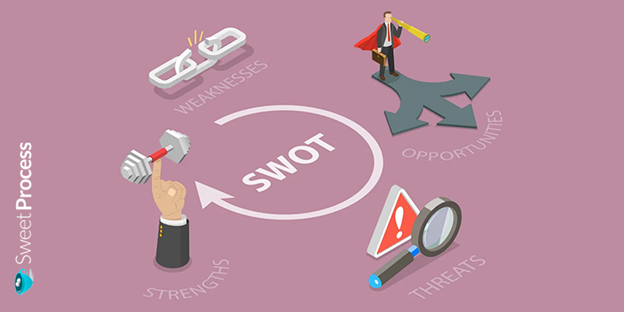
1) Open up a spreadsheet and fill in your business name in cell A1. Then, add a column to the right of it for each of the critical points you need to consider when doing a SWOT analysis:
- Strengths
- Weaknesses
- Opportunities
- Threats
2) In another column beside the four you just added, rate each factor on a scale of one to 10. The lower the number, the weaker that particular area is.
3) Now you can examine each factor individually using this rating system to see where you are at the moment and how far you have to go before your business begins to take off. As an example, let’s say one of the keywords in your analysis of strengths is customer satisfaction. Your ratings might look like this:
1) Strengths: Customer satisfaction = 9
2) Weaknesses: No social media presence invested in = 3
3) Opportunities: A new set of customers just moved into town = 10
4) Threats: The local supermarket is planning to run a big promotion next week = 5
Where would you focus first if you were going to do something about these ratings? Opportunities and strengths require more attention than weaknesses and threats. Even though customer satisfaction is a strength, the low rating means you must be doing something wrong. You might not have a social media presence because you think you don’t need it, but the threat of a new competitor suggests otherwise.
Focus on your strengths because they are strong enough to push your business forward. But pay attention to your weaknesses so you can create initiatives that will improve their scores before they become serious problems.
Now let’s take a closer look at each area of SWOT analysis for marketers:
1) Strengths: Most companies begin their analyses with this section because it’s the easiest to do. They know what they are good at. So, take some time to think about how your brand is perceived in the marketplace and what benefits you can tout as being specific to your business no matter who your competitors are.
2) Weaknesses: It’s normal to spend less time focusing on weaknesses because we don’t like thinking about them. But SWOT analysis is meant to point out your shortcomings so that you can work toward a solution. Be sure to give each one a fair share of your thought process so you have a complete picture of what will be required for your company to climb that next rung on the ladder. If you can’t do it alone, start looking for resources that will strengthen your weaknesses and help you move forward.
3) Opportunities: As a marketer, this is your chance to dream big and then find ways that will help you realize your wildest dreams. The whole point of SWOT analysis is to challenge the status quo, so take advantage of this opportunity before your competition does.
4) Threats: A threat can come from any place, so it’s important to scout the marketplace every day for signs that someone is moving in on your turf. Identify them and then start planning how you will combat them before they become an issue that affects your brand. This is the time to take a good look at your competition and what they’re doing well. Copycats always follow success, so you can create initiatives to avoid becoming their next target by understanding their strategies.
One final note about SWOT analysis: Don’t let the process become overwhelming or time-consuming. Focus on the areas that will result in your most significant advantage, and then take one step at a time to ensure success.
PEST Model
Philip Kotler, often described as the father of marketing, introduced the PEST model (political, economic, social, and technological) in 1971. The PEST model is used for analyzing the external environment in which an organization operates. It helps to understand the political, economic, sociological, and technological forces that affect the business.
PEST helps to understand which forces are more influential for a particular industry or organization and generate appropriate strategies accordingly. This helps in anticipating the impact of these forces so that organizations can be prepared to adopt a suitable strategy.
The following are the steps involved in PEST analysis:
1. Identify the forces that can affect your business.
2. Analyze and interpret the data and present it systematically.
3. Identify external opportunities and threats.
4. Anticipate the impact of these forces.
5. Generate strategies accordingly.
PEST analysis is mainly used for strategic planning to understand the business position, potential, and guidance for operations.
Porter’s Five Forces
Porter’s Five Forces was created in the 1990s by Michael Porter. They can be applied to just about any industry and business.
It is helpful to recognize that the five forces don’t have a “right answer” as a quick beginning point. It would be best to look at the specifics of your industry, your strategy, and your competitors to determine what is best for you.
The five forces are:
1. The threat of substitution.
2. The bargaining power of buyers.
3. The bargaining power of suppliers.
4. The degree of rivalry in the industry.
5. The threat of new entrants.
The five forces are used to determine where the industry is, where it is going, and what strategy you should use.
There are many ways and combinations of these forces to use in your strategy. It is a strategic tool, not a tactical decision-making tool. It is supposed to find the best solution for your business, not the best way to get a job done. If you use the five forces as a tactical decision-making tool, you can very easily create more problems and conflicts than you need.
Strategy Map

What are your goals for the next 12 months? Are you trying to achieve a strategic plan in business, not just an annual marketing strategy?
One way of achieving your goals is to develop a strategy map. Strategy maps combine strategies through time and across organizational levels. They help you to create a strategy for your organization and individual team.
A strategy map is also used in scenario planning, which can help you set out what might be possible if certain hypothetical conditions or expectations are realized.
A strategy map involves the people responsible for a strategy and active use of these people’s visual and cognitive skills. This dynamic use helps to clarify the map, which becomes an instrument of communication at both individual and organizational levels.
An example:
A company should have a strategic plan and a strategy map, showing the feasible paths from today to the future.
What is required for this to work?
1. Start with an overall strategy.
2. Decide on the basic version of the strategy, possibly also showing strategic objectives as business goals, business objectives, business principles, business policy.
3. Use a strategy map to make the strategy more concrete, showing strategic elements during period 0 (the present) through to period 12.
4. Connect the strategy map to your organization’s mission and vision statements.
5. Connect the strategy map to your business model or key processes.
6. Connect the strategy map to current and possible technologies, possibilities, and market conditions.
7. Evaluate, revise, and possibly develop new possibilities (but not before period 10!) for the future.
8. Develop a new vision for your company’s future based on the strategy map.
9. Communicate the revised strategy map.
Balanced Scorecard
A balanced scorecard (BSC) is typically used in strategic planning. The BSC quantifies the three perspectives of the organization’s strategy: financial, operational, and so-called “asset” or “investment.”
The BSC is often used with the balanced scorecard development process (BSCDP). It is important to note that although an organization might have a strategy, it can still struggle to implement and realize that strategy. You cannot just say, “We are a community organization overseas that won’t make any mistakes” and be successful. It is possible to fail at almost anything, even the most simple things. Risks are involved in everything we do, and any plan can go wrong. This is why it is essential to compromise and think of a secondary plan if the primary plan fails.
A balanced scorecard (BSC) was designed by Robert Kaplan and David P. Norton, a professor at Harvard and a co-founder of the Palladium group. They wrote the book The Balanced Scorecard: Measures That Drive Business Results, in 1985. A BSC encourages the organization to think about the “big picture” of what it is trying to accomplish and devise a plan of action.
According to Kaplan and Norton, “It is a management system that associates financial measures with the customer, employee, and internal-organizational performance.” Through performance measurement, an organization can achieve its mission. Strategic planning to implement and accomplish the organization’s mission is the primary goal of a BSC.
A BSC can be used effectively in any organization. There is no set “goal” of a BSC and no limit to the amount of information used, as long as it is all part of the strategy.
The most common type of BSC is a financial BSC. A financial BSC focuses on the organization’s finances. Each element measures financial results rather than the other statutory elements of a balanced scorecard. This type of BSC was aimed at large and complex organizations that do not require the flexibility of a functional BSC. The financial BSC, typically called a “standardized balanced scorecard” or “matrix,” is simple and easy to understand. The primary benefit of this type of BSC is that it provides a single set of metrics to track and manage enterprise performance.
A functional BSC highlights processes, such as customer service and outcomes of the organization’s operations. The ideal function is to measure every process at every level to streamline the performance measurement process. This, however, is unrealistic. When creating a functional BSC, the most important thing to remember is to measure only the processes that matter to the organization, not every possible method.
Gap Planning
Gap planning is a framework for strategic planning. It consists of two broad steps: gap analysis, which involves identifying the emerging trends and opportunities in an industry, and gap creation, which focuses on developing a company’s strategy to capitalize on those trends or opportunities.
Gap analysis involves identifying critical trends in the market, particularly changes that will affect a company’s position or future direction. These trends are usually placed by observing consumer behavior, following industry developments and news, and studying consumer demographics. For example, if a company wants to get into a new market, it might look at its competitors’ positioning and their plans for entering the market.
Gap creation involves developing the elements of a gap strategy, such as goals and objectives. This process usually selects and prioritizes the most important trends and opportunities. Because resources are limited, you may choose some options over others.
VRIO Framework
VRIO framework is a tool for strategic planning developed by the University of Texas at Dallas. It is an acronym that stands for value, rarity, inimitability, and organization. Businesses use the tool to identify the resources they have that give them an edge over other companies in their industry. These can include anything from pricing strategies, marketing tactics or customer loyalty programs- it all depends on what makes YOU competitive!
The framework is used for strategic planning, and executives can apply it to any organization to define its mission and vision. Starbucks and Dunkin Donuts have successfully implemented VRIO. The framework states that there are four main criteria on which you should measure resources:
Valuable resources compete with rare things that are highly valued and difficult to imitate, such as patents.
Rare resources offer alternate use that is hard to replicate. For example, suppose an organization creates a physical good that would be very hard for competitors to develop themselves. In that case, it may be difficult for them to produce the same product at either the same quality or lower prices.
Other organizations cannot imitate inimitable resources; it is difficult to replicate the actual resource and create a similar product. For example, suppose an organization invests in developing a unique physical product. In that case, competitors may find it hard to build something similar because of the amount of time and money it would take them to create the same product.
Organizations can manage resources that are under their control. Thus, one cannot control something lost to competitors (e.g., through sale or merger) or something that is not within an organization’s reach, such as natural resources beyond its area of operation (e.g., oil wells).
VRIO framework is used by organizations to identify their most valuable and rare resources and those that can be imitated or controlled.
Once these resources are identified, the organization can develop a strategy to use them and thus establish a competitive advantage over its competitors.
Theory of Change

Theorists in strategy have proposed a theory of change (TOC) model. A TOC model is often used as part of a strategic planning process to help strategists understand what it will take to achieve their plans and visions. TOC models are usually created using three essential components:
- The problem or challenge that needs to be solved.
- The starting point (current situation).
- The end-state vision of what the organization wants to achieve.
The TOC model can be thought of as a cycle with the steps broken down into four parts:
- Understanding the problem, challenge, or opportunity.
- Developing the potential solution.
- Evaluating and refining the answer.
- Implementing and testing the solution.
As a strategic planning tool, a TOC model can be used as part of an organization’s five-year strategy. The TOC model can be used in the first year to create a vision for what the organization wants to accomplish over the next five years. Organizations can then use it in year two to break that vision into a series of objectives and activities. In subsequent years, you can repeat the cycle as necessary to refine the organization’s goals and activities.
Proponents believe that a TOC model can create strategies, goals, and initiatives that go beyond simply responding to day-to-day issues and emergencies. Instead, they think that a TOC model can produce strategies and initiatives to solve problems and take advantage of opportunities.
Hoshin Planning
Hoshin planning is a method for implementing and systematically managing strategy. Many firms in Japan, such as Toyota, use hoshin planning, and some firms have also adopted it in Europe and the United States. Hoshin planning is just one aspect of a more comprehensive approach to managing corporate growth called strategy deployment.
Traditionally, the essence of strategy deployment was to “install” a company’s strategic plan, often focusing on short-term quarterly financial goals. However, hoshin planning is distinctive because it focuses not only on short-term financial goals but also on creating long-term strategic goals, monitoring strategy implementation, and adjusting the company’s direction as necessary.
Hoshin plans are typically composed of long-term strategic goals. These generally are stated in terms of an XYZ goal, where XYZ represents a significant challenge or issue (e.g., to increase sales), and goals represent responses to XYZ (e.g., increase sales by 10 percent).
Hoshin plans are made of several smaller initiatives (actions). An initiative is simply a step taken to move toward the goal. For example, if XYZ aims to increase sales, initiatives might include “launch new product line” or “train salespeople.” Each initiative has a target completion date and is assigned to one or more individuals accountable for its success.
The term “hoshin” refers to “directional arrows.” These arrows are drawn on the planning map to represent the direction of the activity. Hoshin plans are typically removed in four dimensions: north at the top of the map, east to the right, west to the left, and south below. The XYZ goal is typically placed in the center of the plan, with initiatives radiating from it.
Upward-pointing directional arrows indicate that if an initiative succeeds, the activity under its control will positively affect the goal. For example, if one industry is targeted to “increase sales by 10 percent” and succeeds, the XYZ goal would be positively affected.
In contrast, downward-pointing arrows indicate that if an initiative succeeds, then the activity under its control will harm the goal. For example, if an initiative is targeted to “reduce costs by 15 percent” and succeeds, the XYZ goal would be negatively affected.
Finally, diagonal arrows indicate that if an initiative succeeds, then the activity under its control will have a neutral effect on the goal, meaning that the initiative has no impact on the XYZ goal and that there is no relationship between the two.
The critical distinction between hoshin planning and traditional strategic planning is that hoshin plans do not simply “install” a company’s strategic plan. Instead, the plan is dynamic and is reevaluated and revised each year. This annual revision process, called “mid-course correction,” typically incorporates changes in the environment and the company’s execution of its strategy.
The mid-course correction process evolves in three stages. The first stage is to revise strategic goals, typically adding new destinations and deleting old ones. The second stage is to review initiatives, which typically involves adding initiatives that were not identified at the start of the year and deleting initiatives that will be complete. Finally, the third stage is to review activities, which typically involves reassigning activities from one person to another based on who is best suited to lead the movement.
OKR Framework
How do you know if your company is on the right track? It’s hard to tell. You’re not sure what metrics are essential and how you should measure them. The OKR framework can help! This strategic planning model has helped companies like Google, Intel, and GE set their priorities for years. OKR stands for objectives and key results.
Objectives are the big picture corporate or company goals that you’re trying to achieve over some time (e.g., grow revenue by 25% in three years).
At the same time, key results are the measurements you need to look at to see if you’re on track. They’re the measurements that will help you figure out how close you are to reaching your objective. It’s important to note that you don’t have just one objective or one key result—you need at least two (at a high level).
You need objectives to be SMART. A good objective should complete these five things:
- Be specific
- Be measurable
- Be attainable (and relevant)
- Be realistic
- Be time-bound
When setting objectives and key results, it’s essential to think of them as a system. Use them as part of your overall strategy and plan, not on their own. If you don’t, you’ll run into problems.
Sometimes companies will try to set objectives and key results competing against one another. For example, if you had an objective of “become a market leader in this space” and a key result that reads “increase revenue by $2 million,” those objectives would be competing against one another. You might be increasing revenue, but you’re not going to be a market leader with those results.
Other times, people will try to measure success with too hard a result. One of the most important things when setting objectives and key results is to make them specific enough so you know when you’ve achieved the goal. If they’re too general, it’s hard to tell. You need to have key results with a specific number, a timeframe for achieving it, and a way of measuring it.
Step 3: Develop Your Strategy
Reshape your organization’s vision
Reshape your vision statement so that it is concise and easy to understand. For example, “To be the best company globally” could be simplified to “To be the top company in the industry.”
You should write your vision in a language easy to understand by people unfamiliar with your business. It should be a concise yet vivid description of where you want your company to be in the future and must provide direction and guidance for decision-making and planning by all organization members.
Your vision statement will become your guiding light in the long-term plan process.
Write a clear mission statement
A mission statement is defined as the sentence or two that describes your business’s core purpose, values and focus by providing a context for making future decisions.
Your mission statement should also contain your strategy for delivering on your vision. It should feel vital to the employees and customers of your business, and it must include words that connect to them emotionally.
Therefore, it should be seen as a guide to help you decide which route you will take to fulfill your vision. Here’s an excellent example of a mission statement:
“To be the premier company in our market, providing exceptional customer service and high-quality products, by working with integrity as a team and maintaining open communications.”
When creating a mission statement, ask yourself the following questions:
1) What is my company’s purpose? Why does my company exist?
2) How is my company different from our competitors?
3) What are my company’s values?
4) What is my company’s focus?
5) How does this mission statement connect to customers emotionally so they want to do business with us? How will our customers feel when they read it?
6) Is this mission statement effective outside of my organization?
7) How could I improve upon this mission statement before finalizing it?
Redefine your core values
Redefine your core values in a way that is easy to understand for all team members.
Your core values should be understandable by everyone in the company, including staff, management, and executives. They are not meant to be complicated—they’re supposed to provide guidance and motivation for how employees work together and make decisions daily.
Examples of core values are integrity, respect, teamwork, innovation, passion, and customer service.
It will help if you distill them into a shortlist of keywords that are easy to remember and roll off the tongue. They could be put as an acronym.
Once you have identified your core values, write them down. Post them in public places throughout your office or billboards about town so employees can constantly keep them in the front of their minds.
By identifying your core values and internalizing them, your employees will better understand how they can contribute to your company’s success.
Every employee should have a role in helping you achieve your vision by focusing on their most important priorities every day.
Identify your competitive advantages
The first step in identifying your competitive advantage is understanding what you do that makes you different from other companies. This will help you develop a strategy for the future and make sure that you are not going down a path of redundancy or obsolescence.
To begin with, think about how you can differentiate yourself from your competitors. What is it that you offer that they don’t? Why should customers choose you over them?
How does your product/service fit into the market? Do you have something unique that sets you apart? If so, what is it?
What is the difference between your company and its competition? What is their business model? What are their strengths and weaknesses?
If you find that there isn’t anything special about your company, you need to start thinking about what you could be doing differently. Perhaps you could try offering more services or products than your competitors. Or maybe you could focus on one particular area of expertise rather than trying to cover everything under the sun.
Once you have identified your competitive advantage, you need to ensure that this remains strong throughout the development of your strategic plan. You may want to consider:
- Developing new ways of delivering your service/product.
- Differentiating yourself by focusing on specific markets.
- Offering additional services or products.
- Making use of technology.
- Providing customer support.
- Being innovative.
- Having a good reputation.
- Becoming more efficient.
- Increasing productivity.
- Improving quality.
- Reducing costs.
- Maximizing profits.
- Creating an environment where employees feel valued.
- Ensuring employee satisfaction.
- Attracting new clients.
- Building brand awareness.
Step 4: Build Your Plan

Set your priorities from your SWOT
When developing a strategy, it is essential to prioritize your strengths and weaknesses. You must identify what you do best and what you need improvement on. This will help you develop an effective strategy that will lead to success.
Define your goals
After you have identified the strengths and weaknesses of your business, it is time to set some goals. It would be best to determine what you can do to improve your weaknesses and use that information to better yourself. Set short-term, mid-term, and long-term goals so that you can continue making progress toward success.
Set your objectives
After you have identified your goals, the next step is to set your objectives. This will help you determine what you want to achieve and how you will do it. Setting objectives can be a difficult task as there are many different ways. Some people prefer to write down their objectives, while others use an objective-setting tool. Whatever method you choose, make sure you keep them simple and achievable.
The first step in setting your objectives is to identify your target audience. Who do you want to reach? What type of information or service do they need? Once you know who you are targeting, you can start thinking about what you want to achieve for each person.
For example, if you are writing a blog post, think about what you want to say and why you want to share it with the world. If you are creating a website, think about what kind of content you want to provide and how you want to present it. Think about whether you want to start something informative or entertaining. You may even want to consider creating both types of content so that you can cater to all tastes.
Once you have thought about what you want to offer, you should also consider what you want from your potential customers. Do you want them to buy something? Are you looking for feedback on your product or service? Or maybe you just want to get more traffic to your site. Whatever your reason for attracting new visitors, you must decide what you want to achieve before planning your strategy.
Set your KPIs
Now that you have set your objectives, the next thing to do is put your KPIs (key performance indicators) into place. These are the things you want to measure when working toward achieving your objectives. They are the key indicators that show whether you are making progress or not. Once you have decided what you want to achieve, you need to determine what you can measure to see if you are getting closer to reaching those goals.
For example, if you want to increase sales, you can look at the number of leads you generate per week. If you’re going to improve customer satisfaction, you can look at the percentage of positive reviews that you receive online. And if you want to increase brand awareness, you can look at how often you appear in Google searches. There are many other examples, but these are some of the most common ones.
Convert strategies to operation
Now you need to convert strategies to operations. This means that you need to make sure you put plans into action. When you set up your strategy, you were probably given a lot of ideas. But you need to ensure that you turn those ideas into concrete actions. Otherwise, you won’t know if you are meeting your targets.
You need to figure out which of your strategies will take longer than others. Then you need to decide how much time you are willing to spend on each one. Don’t forget to factor in any costs involved as well. For example, if your company has an office space that needs to be maintained, you will need to budget money.
You also need to think about what resources you need to carry out your plans. This includes people, equipment, and materials. You may need to hire extra staff members to handle specific tasks. You may also need to invest in expensive machinery and purchase marketing materials such as brochures, flyers, and posters.
It would help if you also considered how you would implement your plans. Some companies use a formal process called “project management.” Others prefer to keep their plans simple and rely on old trial and error. Whatever method you choose, you must stick to it so that you don’t end up wasting too much time and energy.
Once you have completed all of the above steps, you should start thinking about who will carry them out. The first person that comes to mind is usually the CEO. However, it’s worth remembering that they aren’t the only person with influence over your business. Your employees are just as important.
If you have a large workforce, you will need to break your strategy into smaller parts. Each department should be responsible for implementing its part of the strategy. This way, everyone knows exactly where they stand and what they are supposed to be doing.
If you have a small team, you might be able to get away with having one person focus on the whole strategy. However, it’s always best to split responsibilities among different team members. This way, no single member feels like they are being left out.
Make sure that everyone understands why they are working toward achieving your goals. It’s not enough to tell them what your goals are. They must know why they are helping you achieve them.
Finally, once you have worked through all of the above steps and developed a clear strategy, you need to communicate it to your team. Ensure that everyone knows their role and what they are expected to do. If necessary, give them some training or coaching to help them learn new skills.
Step 5: Implement Your Strategy
The last thing that you want to happen is for your strategy to become outdated before it even gets off the ground, so make sure that you have an operational plan in place.
Create a yearly operational plan
Operational planning is the process of transforming your strategic plan into a comprehensive map that lays out exactly what actions your team will take on a weekly or even daily basis. An operational plan will include action items and milestones that each team or department must meet to implement your strategic plan.
Outline each team’s or person’s tasks for the upcoming quarter, six months, or fiscal year throughout the operational planning process. If you’re a fast-paced team with a tight timeframe, consider drafting an operational strategy for the next quarter or half-year. If your company is more long-term oriented, prepare an operating strategy for the entire fiscal year. It is an excellent idea for the plan to include a budget.
Set measures for tracking goals and monitor
According to Benjamin Franklin, one of the prominent figures of American history, “If you don’t plan, you’re preparing to fail, but if you don’t track, you’ll almost certainly fail to achieve your intended future condition.” Executives should monitor the implementation of your plan on a frequent and periodic basis to ensure that it is continuing on track. It has to be prodded back on course if it isn’t on track.
Executives can hold regular meetings to discuss their current situation and plans. Or you could send out emails asking for feedback from your team members. Either way, you need to ensure that your strategy stays relevant. Otherwise, it won’t serve you well.
Evaluate and review
It is always a great idea to stop and assess yourself. You need to develop an evaluation tool to see if you are in line with your strategy to achieve your goal or if you are derailing. This helps to keep you and your team in constant check during implementation.
Now that you know more about developing a successful strategy, you can put it into practice. But if you want to succeed, you need to work hard and stay focused. That means making sure that you don’t waste any opportunities. You can achieve this by deploying software to help manage projects and keep you on track.
Chapter 4: Top Seven Software for Strategic Planning

Strategic planning software assists companies in identifying and defining their short- and long-term objectives and priorities. It enables users to choose from various paths to accomplish their goals and track their progress. Additionally, it allows them to collect and track information from concept to implementation in one location. Below is a list of the top seven software for strategic planning in no particular order.
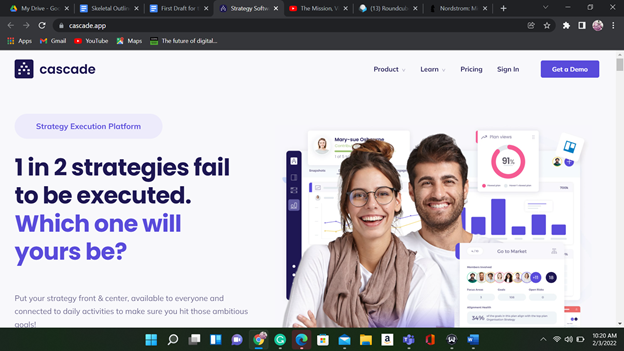
Cascade Strategy, founded in 2012, is an Australian software company used for strategic planning. Cascade Strategy offers written materials, webinars, live internet sessions, and in-person meetings.
Cascade Strategy is a SaaS-based software bundle. Cascade Strategy is a collaboration software that includes budget management, milestone tracking, percent full tracking, portfolio management, and project planning. It uses traditional and agile methodologies, Gantt charts, idea management, cost-to-complete tracking, customizable templates, client portal, kanban board, and collaboration tools. It offers a free trial.
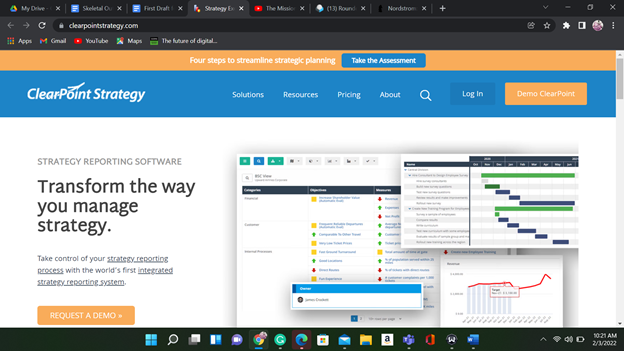
ClearPoint Strategy is a strategy management application that enables corporate executives to handle scorecards more effectively and efficiently. The balanced software scorecard (BSC) from ClearPoint enables executives to easily manage objectives, measurements, initiatives, and action items in one location.
ClearPoint’s scorecard feature lets users construct a single scorecard or multiple cascade scorecards to track performance across different divisions, departments, and teams. ClearPoint enables customers to modify their scorecards to meet their specific requirements. Users may manage views, topics, objectives, measurements, and initiatives with the program’s assistance. Users can construct custom reporting fields in ClearPoint to conform to their organization’s specific approach.
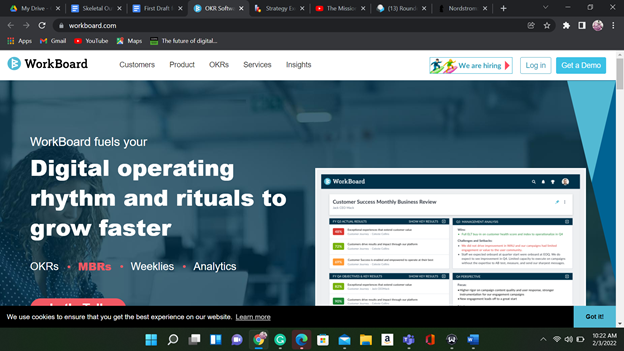
Workboard is a cloud-based tool for strategic planning, cooperation, communication, and tracking staff objectives and performance. The application is delivered as a cloud-based service and includes native iPad, iPhone, and Android devices.
The workboard business velocity platform enables employees to set and manage objectives and key results (OKRs) and tie them to their organization’s business strategy. Workboard includes bar graphs, charts, and other data visualization tools that enable managers and authorized workers to evaluate individual employees’ progress toward goals and the link between those goals and corporate plans. The device can anticipate the likelihood that an employee will achieve their goals based on the current path and pace of work.
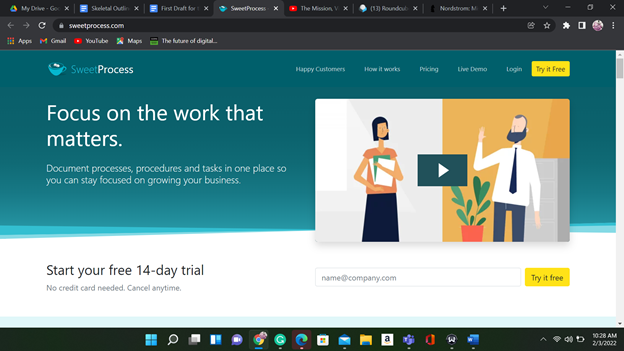
Organizations can use SweetProcess software to track the progress of a company’s operational plan. It is a SaaS solution for mid-sized, corporate, and international businesses that simplifies and streamlines the process of establishing standard operating procedures (SOPs), including sharing procedures with a team.
SweetProcess includes documenting standard operating procedures, training new employees on existing processes, and visualizing all process activities.
Its uniqueness lies in its ability to track progress as a worker moves through a process. SweetProcess includes a mobile device user interface that identifies ways to streamline processes, file attachments, comments and collaboration, drafts, and approvals. It also includes task assignment and tracking, auditable with Excel export, Word and PDF procedure export, two-factor verification, and email and phone support. It also supports cloud storage.
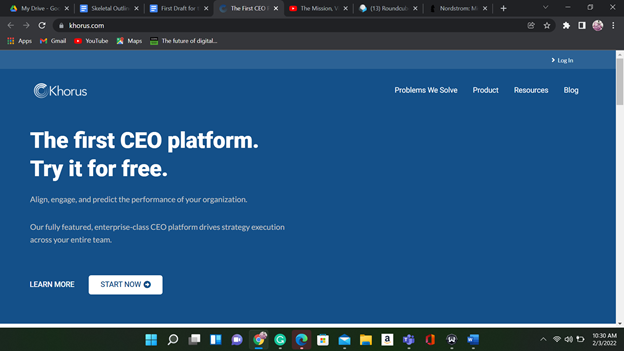
Khorus is used for strategic planning. It is a platform that collects weekly predictive data from employees in the organization. Khorus has a calendar, an agenda, and a to-do list. It also allows you to create different events (meetings, presentations, etc.) and track them. You can use it to plan meetings with your team members or even schedule time for yourself.
You can use Khorus to manage projects in your company. For example, if you are working on a project that requires several people to work together, you can set up a meeting using Khorus. The participants will see what’s going on and when they need to attend.
You can also use Khorus to collaborate with other teams in your organization. This way, everyone knows who needs to do what at any given moment.
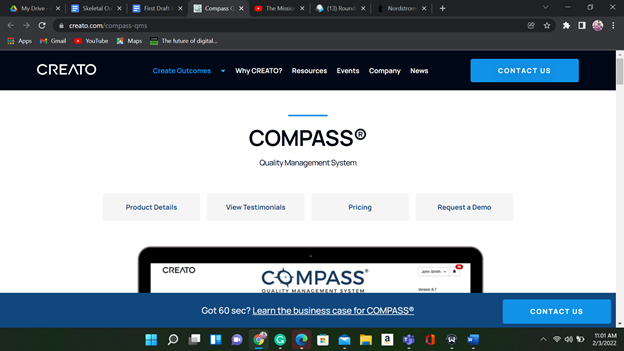
COMPASS® is a project portfolio management solution that helps your company maintain its quality and performance improvement efforts. COMPASS generates a list of potential improvements automatically prioritized for management’s consideration.
Projects are resourced on a timely basis, and improvement teams are coached through the work required to achieve breakthrough improvement, step by step. The most appropriate tools for each situation are suggested and available to the end-user.
Real-time reports are offered in A3 format, the preferred reporting format for many businesses today. Increase your return on investment from improvement work by completing more projects—and all tasks in less time—than previously. Although firms with prior expertise with lean and Six Sigma principles will be able to implement COMPASS swiftly, any organization with a desire to improve can use it to achieve higher performance levels.
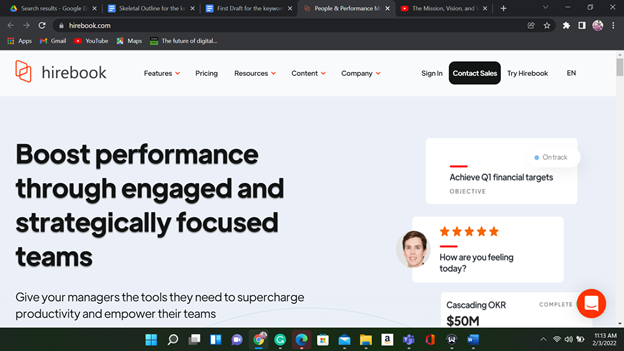
Hirebook is a people-focused software that helps businesses empower their teams by incorporating check-ins, OKRs, KPIs, and action items into a comprehensive meeting tool. It allows managers to check in with employees, gives a dedicated space to share progress and discuss employee development, and incorporates OKRs into everything your team does to ensure that strategy is aligned across the organization. Hirebook’s strategic services are a winning combination for every employer trying to boost engagement.
Choosing the Best Strategic Planning Software
There are three significant features to look out for in software that allows you to create your strategic plan:
- A user-friendly interface.
- The ability to import and export data.
- A timeline for goal tracking.
A user-friendly interface is essential because it makes the software more efficient for you, usually allowing you and your team to navigate the software quickly and save time.
Importing and exporting data is essential because if information needs to be imported from other software, it allows you to do this more easily, and exporting can be done without hassle.
Goal-tracking is necessary for any strategic planning software because it will track your goals and show you what has been achieved and what is yet to come.
Cloud storage is also essential when choosing software because it allows you to access your plan from multiple devices, and this becomes very handy when planning on the go.
Chapter 5: How to Adapt and Evolve Your Strategic Goals Using SweetProcess

Many businesses struggle to keep track of their processes, tasks, and strategic plans. Without a process in place, it can be hard to know where your business is headed or what needs to be done to get there. Not only that, but not being able to monitor the implementation of your strategic plan can lead to a lot of wasted time and money.
SweetProcess is the solution for you. Our online document management system will help you manage your processes, tasks, and strategic plan efficiently and effectively. Plus, our labor monitoring tool will help you stay on top of your progress and ensure that everything is on track.
SweetProcess has helped many companies upgrade their business and upscale their performance. They have used SweetProcess to evolve and achieve their strategic goals. Find below a few case studies:
If there’s one thing Zen Media knows how to do, it’s to keep its employees on their toes. With a fast-paced and ever-changing industry like media, the company has to ensure that its employees are always up to speed.
And that’s where SweetProcess comes in. The chief marketing officer at Zen Media, Stephanie Chavez, discusses how SweetProces aided them by creating a standard knowledge base for all employees. Zen Media was able to achieve consistency in their team’s performance. No more wasting time tracking down information or training new hires—everything they need is right at their fingertips.
Plus, with SweetProcess’s easy-to-use interface, even non-tech savvy employees can get up to speed quickly, which is excellent.
Now they enjoy:
- Seamless employee onboarding and training.
- Quality control and assurance.
- Standard knowledge base.
As a small business, Resolute Legal was having trouble scaling up its operations. It was challenging to keep track of all the different tasks that needed to be done, and it was hard to make sure that everyone was doing their part.
David Brannen, the founder and managing lawyer of Resolute Legal, discovered SweetProcess and is now happier than ever. With its easy-to-use structure for business operations, Resolute Legal created standard operating procedures for every task in the company. This made it easy to track what needed to be done and ensured that everyone was doing their part correctly.
The results were impressive. The company scaled up successfully, but it also became more efficient and productive.
They now enjoy:
- Efficient employee onboarding and training.
- Central knowledge base.
- Quality control.
- Streamlined workflow.
Another great company that has benefited from SweetProcess is Ginkgo Residential. Their portfolio analytics manager, Sarah Genay, was looking to streamline their workflow to improve employee knowledge and understanding of business processes. They wanted a way to make sure that everyone was on the same page and that they could quickly address any questions or concerns. They turned to SweetProcess for help.
SweetProcess provided Ginkgo Residential with an easy-to-use process documentation tool. This allowed employees to learn about the company’s processes by reading simple, step-by-step instructions. Best of all, if any questions or concerns arose, employees could easily reach out to their colleagues for clarification.
The results were terrific! Employee knowledge improved significantly, and everyone was able to work more effectively together. Ginkgo Residential can now boast of:
- Enhanced business process documentation.
- Fast-track employee onboarding and training.
- Decentralized knowledge.
- Improved workflow.
Make informed choices and use software that helps you plan your strategy and improve your workflow.
Conclusion
Strategic planning is a common practice that allows organizations to get an insight into the future of their business. It has different advantages, which can be seen in all stages of its implementation. However, many companies fail to take advantage of them due to the lack of knowledge regarding these models and processes. Therefore, every organization must acquire a large amount of information about the process and know how it works.
In addition, the study of these models and processes can be helpful to any organization which struggles with establishing a proper planning system. Implementing strategic planning is beneficial for small businesses and larger companies that aim to expand their enterprise or diversify into new areas of business.
We hope that this guide has helped provide you with a better understanding of strategic planning and how it can benefit your organization. To make the process easier for you, we have created a free template that you can download. You can also sign up with SweetProcess for a free trial without the hassle of using your credit card, which will allow you to create and manage your strategic plans.
